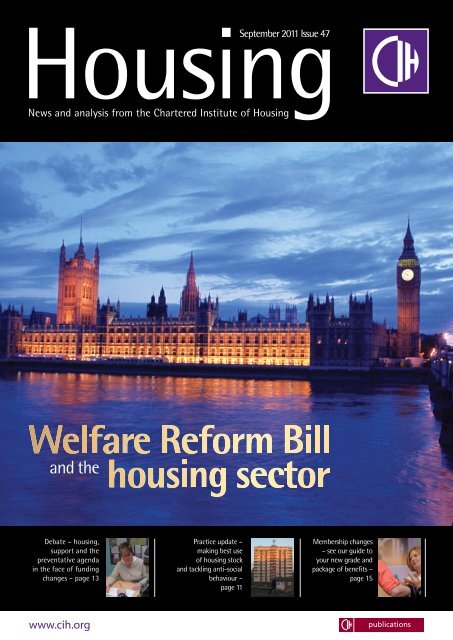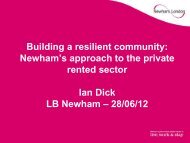news - Chartered Institute of Housing
news - Chartered Institute of Housing
news - Chartered Institute of Housing
- No tags were found...
Create successful ePaper yourself
Turn your PDF publications into a flip-book with our unique Google optimized e-Paper software.
NewsNewsSupport for newdraft planning policyframeworkCIH is broadly in favour <strong>of</strong> the draft NationalPlanning Policy Framework, which sets outa simpler and consolidated approach toplanning in England, and which directly seeksto tackle the huge challenges around housingsupply and affordability.Grainia Long, CIH interim chief executive,said: “Over the last thirty years the failure tobuild the homes we need has left this countrywith a housing crisis which has resulted in ashortage <strong>of</strong> 142,000 homes every year.“The housing crisis is not new, but theproposed draft national planning policyframework provides a golden opportunity toprovide part <strong>of</strong> the solution. The governmenthas recognised that something has to bedone to simplify the planning process andwe applaud this. The reforms to planningwill allow more homes to be built giving thethousands <strong>of</strong> people, who do not currentlyhave one, a decent place to live.”She added: “The draft National PlanningPolicy Framework is clear in its aims; it wantsto provide freedom for every community tohave the homes that they need. But to makethis work, Local Authorities must take thelead in driving this forward; they must engagewith residents and decide when to make thecase for new housing that helps local peopleand economies.”The framework seeks to make it easier to gethomes built, which gives a great opportunityfor a general increase in the number <strong>of</strong>This issue <strong>of</strong> <strong>Housing</strong> comes at a sad time for allstaff, trustees, members and friends <strong>of</strong> CIH aswe mourn the loss <strong>of</strong> our Chief Executive SarahWebb who died on 4th September after a period<strong>of</strong> illness. We extend our sympathies to her familyand friends.Sarah’s death is an enormous loss and we areincredibly sad. I can think <strong>of</strong> no better colleague,no better inspiration and to many <strong>of</strong> us no betterfriend. It has been a privilege to work with Sarah.I would like to thank all colleagues and friendsnew homes in the right places. There is areal imperative for strong local authorityleadership to ensure effective approaches toplanning at the local level. Being firm andclear in the identification <strong>of</strong> land will enablewidespread fears about development inunsuitable areas – such as the green belt -to be allayed.Furthermore it provides Local Authoritieswith the flexibility to be creative and affordschoice in how they <strong>of</strong>fer housing – fromusing existing properties which are empty, tobeing able to meet the demand for smallerhouses by building one bedroom homes.The framework is underpinned by the needfor Local Authorities to produce a robustand strategic single Local Plan, supported bydetailing what development they expect tosee in those areas. Robustly assessing localhousing need and identifying the mix andtype <strong>of</strong> housing needed in local areas will bevital.It is also very clear that any newdevelopments will need to ensure they aresocially, environmentally and economicallysustainable, that they should reflect localcharacter and respect the historic and naturalenvironment and that designated greenbelt areas are protected. The frameworkstresses the importance <strong>of</strong> the Green Beltand associated protections for Areas <strong>of</strong>Outstanding Natural Beauty (AONB) andenvironmental areas and these will be pickedup in Local Plans.Grainia Long added: “The benefit <strong>of</strong>providing people with decent housing haswidespread benefits throughout our societyand for the economy. House building iseditor Jill Dwyer (02476 851780) Email: jill.dwyer@cih.org • deputy sales manager gemma hunt (020 7772 8419) • design lisa ferron (ferron@intelynx.net) • printers william gibbons (01902 730 011)distribution UK & Overseas via COMAG (01895 444055) • The deadline for editorial contributions for the next issue is 28 October 2011.The publishers accept no responsibility for unsolicited manuscripts or photographs. If you are sending material to us for publication you are strongly advised to make copies and to include a stamped, self addressed envelope.Original material must be submitted and will be accepted solely on the basis that the author accepts the assessment <strong>of</strong> the publisher as to its commercial value.for their warm wishes. We have created a page <strong>of</strong>tributes online at www.cih.org/SarahWebb-tributes.htm If you would like to share your memories<strong>of</strong> Sarah please emailpress@cih.org.We also pay tribute toher in a special featureon page 5.Grainia LongInterim Chef Executivecurrently at its lowest peacetime levels since1924, if we do not do something to reversethis trend the impact will be far further afieldthan just a shortage <strong>of</strong> houses.“We urge the government to deliver theNational Planning Policy Framework, butwe also want them to address our concernsaround the capacity and willingness<strong>of</strong> communities to take control <strong>of</strong>neighbourhood planning, and to articulatemore clearly the role <strong>of</strong> local councils andcouncillors in leading the planning process.”International <strong>Housing</strong>Summit has over 40speakersCIH is working in partnership with OceanMedia Group (organisers <strong>of</strong> the annualCIH conference and exhibition) to createthe International <strong>Housing</strong> Summit, a newconference for the global affordable housingsector.Over two days <strong>of</strong> conference presentationsand themed working lunch sessions, morethan 40 speakers from housing sectorsas diverse as Australia, China, Brazil andGermany will address delegates. Speakersfrom CIH include President Helen Collins,Interim Chief Executive, Grainia Long,Assistant Director <strong>of</strong> Policy & Practice, AbigailDavies and Dr. Ngai Ming Yip, Vice Chair, CIHAsian Pacific Branch.The Summit, on 1st and 2nd Novemberin Rotterdam, brings together seniorpractitioners to share best practice withcolleagues as they seek lasting solutions tocommon challenges. Nearly 300 delegatesfrom 22 countries gathered in The Hague forthe first International <strong>Housing</strong> Summit inOctober 2010.The Summit supports CIH’s commitmentto building a global community <strong>of</strong> housingproviders committed to delivering thevery best for their tenants. CIH President,Helen Collins, says: “<strong>Housing</strong> faces a crisisworldwide; despite the differences infinancing and regulatory approaches acrossthe globe, as affordable housing practitionersand policy makers we face many commonchallenges. The International <strong>Housing</strong> Summitis an invaluable opportunity to take awayideas and connections that will help shapeyour organisation and sector for the future”.The Summit includes:• Three optional study tours to projects inthe Rotterdam and Amsterdam areas,where delegates will meet with housingpr<strong>of</strong>essionals and tenants• Working lunch sessions addressing the keyissues facing the sector today. Hosted by arange <strong>of</strong> experts in the field, these sessionswill provide focused debate in a relaxed andinteractive setting• A brand new pre and at-conferenceonline networking tool that helps youarrange meetings and catch up with thepeople you need to meet• Post-conference report and action planwhich acts as an invaluable ongoingreference tool• Networking opportunities at the welcomedrinks, networking reception and extendedbreaksVisit the website atwww.internationalhousingsummit.com forprogramme and study tour details, and tobook your place.Positive Action leads tosuccessDebbie Smith, whose life has been turnedaround by a trainee scheme for disabledpr<strong>of</strong>essionals, is getting a brand new start as aDebt Advisor with New Charter <strong>Housing</strong> Trustthis month (September).Debbie was the first member <strong>of</strong> the CIH’sPositive Action for Disability scheme to securea permanent position in housing, having beenrecognised for her achievements during hertwo-year placement with New Charter.Debbie Smith and Gary SharpTwo further trainees have also landed jobsin the sector. Jayne Wallace has started a jobas customer services <strong>of</strong>ficer at Gloucester CityHomes after her two year traineeship withthe organisation. And Eileen Barron starteda temporary contract as a NeighbourhoodServices Officer at Somer <strong>Housing</strong> Trust in July.Positive Action for Disability is alreadyworking with 14 housing organisationsacross England and Wales to <strong>of</strong>fer two-yeartraineeships including a course <strong>of</strong> academicstudy. The traineeships give talented disabledpeople the support and mentoring they needto start a career in housing. The scheme alsohelps organisations address workplace barriersto employing disabled people and helps themto improve their record on tackling inequality,as well as tapping into an important source<strong>of</strong> talent.Debbie said: “I would never have believedtwo years ago that I would find myself in theposition I am now – with a permanent job, doingsomething I really enjoy with a great salary andmost importantly working for a great employerwith great people, in a great environment.Determination alone is not always enough but,coupled with guidance and on-going supportthrough the CIH and my employer, it has shownthat anything is achievable”Gary Sharp, Head <strong>of</strong> Human Resources atNew Charter said: “I’m thrilled with Debbie’ssuccess - she’s been inspirational - totallycommitted to the organisation and the CIHprogramme. She has an abundance <strong>of</strong> positiveenergy and is totally customer focussed - aperfect ambassador for the sector”.Graham Findlay, Positive Action forDisability Manager at CIH said: “I am <strong>of</strong>course absolutely delighted that our firstgraduates from the scheme are being <strong>of</strong>feredpr<strong>of</strong>essional posts that will be the springboardfor a successful career in housing – and I willbe watching their career track over the nextfive years with real interest.”CIH South West bursaryfund applications openDue to the current economic climate andthe rise in housing sector redundanciesCIH South West has opened up its studentbursary scheme to students who are alreadyenrolled on housing courses but who, because<strong>of</strong> a change in circumstance, for exampleredundancy, are now unable to pay theircourse fees and may have to discontinuetheir studies.“We have made this important changebecause we realise that in this tougheconomic climate some students who havestarted on CIH accredited housing coursesincluding distance learning, may not be ableto continue. So if an existing student is ableto demonstrate that their circumstanceshave changed financially between the timethat they enrolled onto the course and thetime <strong>of</strong> their application then we can lookat <strong>of</strong>fering financial support for theseapplicants,” said Ronny Popat, EducationOfficer, CIH South West.Glenn Roberts from Plymouth was ableto take advantage <strong>of</strong> the new terms <strong>of</strong> theScheme. He was made redundant early in2010 and then decided to undertake thedistance learning course with CIH. He said:“I used my redundancy money to help payfor the first part <strong>of</strong> the fees. I had hoped tosecure employment to pay for the remainingfees but was unable to find a job and it wasthe CIH South West bursary that allowed meto continue with the course. Without thissupport I would have had to discontinue mystudies and abandon the course.”The bursary scheme is open to anyoneliving in the South West region interested inpursuing a career in housing and embarkingon a new CIH accredited housing course.The grants awarded vary depending oncircumstances and the maximum availableis 50% for course fees. The scheme can alsobe used to help students with child care,transport, books or other costs.To find out more visit www.cih.org/branches/sw/education/SWStudentSupportFund.pdf.Alternatively telephone: Ronny Popat, directline: 0117 3170713, mobile: 07766 071864 ore-mail ronny.popat@sovereign.org.uk2 / <strong>Housing</strong> / issue 47
ScotlandWhat’s New in the ScottishSocial <strong>Housing</strong> Charter?It’s a reasonable question! Come April 2012, what will the new Charter deliver interms <strong>of</strong> accountability and service improvements that weren’t possible with theexisting Performance Standards? That a performance framework for social landlords isnecessary is not in doubt, but can the Charter in its current draft form provide that?Those, including CIH Scotland, who havebeen questioning the value <strong>of</strong> us allspending time and resources on theexercise <strong>of</strong> developing the Charter have beenclosely examining the recently publishedScottish Government consultation documentto see how workable the draft Charterseems to be and how it compares to existingregulatory standards.But before looking at the detail, it’s worth aquick recap on why a Charter is currently inthe frame. The <strong>Housing</strong> (Scotland) Act 2010,responding to the wider trends in regulationand scrutiny, provided for a new independentregulator and a regulatory regime based onproportionality and risk. This was as opposedto relying heavily on burdensome (for thelandlord) programmed inspections that manyfelt diverted staff away from front line servicesand from a primary aim <strong>of</strong> regulation –continuous service improvement.Mirroring changes across the UK, there isnow a stronger drive in Scotland for sociallandlords to seek the views <strong>of</strong> tenants andother customers on what is measured andhow. The Act also requires the Regulator to“provide a means for tenants to bring to itsattention significant performance failures bysocial landlords”. In practice, this new approachwill see a landlord in future being expected tomeasure and report on its performance in sucha way as to convince the Regulator that n<strong>of</strong>urther investigation or intervention is required.The new Scottish <strong>Housing</strong> Regulator cameinto being in April 2011 and at the beginning<strong>of</strong> September began its consultation on theregulatory framework, with the new regulatoryregime itself becoming operational in April2012. Whilst the new regulatory regime didnot in itself need to create a brand new set <strong>of</strong>standards, the Minister nonetheless announceda new statutory Charter that would replace6 / <strong>Housing</strong> / issue 47the current standards, and began a long round<strong>of</strong> tenant and stakeholder ‘discussions’ inAugust 2010.So, after all the discussion, will the Charterput tenant feedback centre stage? Willit help with the intention to reduce thelandlords’ burden and allow staff to focuson front line services? How easy will it befor the Regulator, landlord and tenantsalike to measure compliance with it? Iseverything in the Charter within the control<strong>of</strong> the landlord, as we were assured it wouldbe? Most importantly, is it likely to lead toimprovements in services to tenants and othercustomers?On behalf <strong>of</strong> housing pr<strong>of</strong>essionals, CIHScotland has sought to play a leading role inputting rhetoric aside and looking in practicalways at whether the Charter will be effective.Right now, whilst we want to be positiveabout the overall intent behind the Charter,we have real worries about it and thinkfundamental changes are needed to the draft.There isn’t time here to examine all the draftoutcomes, but there are 19 which start withthe phrase ‘tenants or other customers aresatisfied that……’. This moves the focus frommeeting the outcome to proving that tenantsor others are satisfied that the outcomehas been met. An example <strong>of</strong> a particularlyproblematic outcome is, ‘Tenants and residentsare satisfied that tenancy conditions areenforced consistently and breaches dealt withquickly’. The first challenge here is that tenantsand landlords are likely to have a differentinterpretation <strong>of</strong> what ‘dealt with’ means.The second is that, depending on how thatis interpreted, it’s not always appropriate (ormay even cut across other policy objectives– such as homeless prevention) to deal withbreaches quickly. Thirdly, it isn’t necessarilystraightforward to gauge tenants’ andresidents’ views and convince the Regulator <strong>of</strong>satisfaction levels.Another example <strong>of</strong> an outcome likelyto cause concern is one that seemsdisconcertingly vague: ‘Homeless people getgood quality temporary accommodationthat meets their needs and locally agreedstandards’. How can the Regulator assess thiswithout setting some sub-outcomes (which itcannot legally do)?The outcome ‘Tenants and residents, ifcausing nuisance or anti-social behaviour,get the support they need to help them dealwith the situation’ is right to focus on thecrucial importance <strong>of</strong> support, but could beplacing a burden on the landlord to providesupport when it does not always have directcontrol over this, and when some tenants andresidents may refuse it.CIH Scotland is far from convinced thatthe current version <strong>of</strong> the Charter will meetthe objectives <strong>of</strong> reducing the burden onlandlords, focusing staff on front line deliveryand improving services for tenants and others.It could create a new industry <strong>of</strong> compliancered tape, drive landlords and tenants todistraction and leave the Regulator unable tomeaningfully assess the quality <strong>of</strong> services.In order to try to steer the Charter’soutcomes in a way that will be moremeaningful and measurable. CIH Scotland hasmet with a practitioner group to inform ourresponse to the consultation and we’rekeen to hear further views - contact us atpolicy.scotland@cih.org. We have to work withsocial landlords, the Scottish Government andothers to put this right.[Note: The Scottish Government consultationruns until 1 November 2011. Both theconsultation document and thediscussion forum can be accessed athttp://housingcharter.scotland.gov.uk/]A sign <strong>of</strong> things to come?<strong>Housing</strong> Benefit changes drive the policy agendaWhen Boris Johnson published his Revised<strong>Housing</strong> Strategy for London at the end <strong>of</strong>August, the headline that emerged centredon the proposals to help social tenants whounder-occupy their homes to move to smallerproperties. The key rationale for such a proposal,particularly in London, is <strong>of</strong> course the need t<strong>of</strong>ree up larger social homes for much-neededfamily housing. However, the proposal itselfand the fact that it seized the media’s attentionis also linked to the forthcoming provisionthat social housing tenants who are underoccupyingtheir home and are in receipt <strong>of</strong>housing benefit will have their benefit reduced.This is a clear example <strong>of</strong> how the CoalitionGovernment’s changes to the benefits systemare influencing housing policy. And althoughhousing legislation and policy, unlike socialsecurity 1 , is a devolved matter in NorthernIreland it is becoming apparent that thehousing benefit changes will have a discernibleimpact on housing policy and practice here.New policies, strategies and initiatives will allhave to take account <strong>of</strong> the changing housingbenefit context and how it might impact on thedevelopment <strong>of</strong> new social housing, allocationspolicy, access to private finance, the private rentedsector and tenancy and stock management.While making best use <strong>of</strong> stock is a coreelement <strong>of</strong> good housing management, therehas not been a sustained emphasis to date onaddressing the issue <strong>of</strong> under-occupation <strong>of</strong>social housing stock in Northern Ireland. Thehousing benefit changes precipitated by theWelfare Reform Bill, however, will force thisissue onto the housing policy agenda given thedouble whammy for Northern Ireland <strong>of</strong> havingthe majority <strong>of</strong> social housing tenants meetingtheir housing costs through housing benefit andaround 70 per cent under-occupation in thesocial rented sector 2 .With proposed housing benefit reductions <strong>of</strong>Northern Ireland1.Although social security is technically devolved in Northern Ireland the parity principle means that any variation from Westminster policy that leads to additional costs will have to be met from the Northern Ireland budget. This is a significantdeterrent to developing a Northern Ireland social security system. However, there are instances where social security policy or provisions in Northern Ireland have not been implemented exactly in accordance with policy and provisions in Great Britain.2.Source: Northern Ireland <strong>Housing</strong> Statistics 2009-2010MOVING FORWARDIn 2012 the CIH Annual Conference andExhibition will move to a state <strong>of</strong> the artnew venue in the heart <strong>of</strong> the vibrant city<strong>of</strong> Manchester. We’re excited about thefuture, and are developing and refreshingthe event to <strong>of</strong>fer even more opportunitiesto learn, share knowledge and bestpractice, network and do real business.Join us at the event’s award winningnew home, Manchester Centralfrom 12-14 June 2012, for this excitingfresh start.For more information visit www.cihhousing.com15 per cent for tenants under-occupying byone bedroom and 23 per cent for those underoccupyingby two bedrooms the likelihood <strong>of</strong> anumber <strong>of</strong> social tenants being forced to moveout <strong>of</strong> their existing homes is high. But wherewill they go? Is there enough housing stock <strong>of</strong>the right size to meet this new aspect <strong>of</strong> housingneed? Are the resources in place to proactivelymanage transfers on this scale? And last butmost certainly not least, what will be the socialimplications for tenants (especially those whoare older and have lived in their house most<strong>of</strong> their lives) having to leave their homes andneighbourhoods because they can no longerafford to live in them?The housing benefit debate in NorthernIreland has thus far focused on the impacts onindividuals and families and rightly so, althoughthe implications for housing organisationsand private landlords from direct payment <strong>of</strong>housing benefit to tenants are also increasinglya subject for discussion. What must come nextis comprehensive consideration <strong>of</strong> what thehousing benefit changes will mean for thehousing sector and how we can prepare for thenew challenges we will face as a result.<strong>Housing</strong> / issue 47 / 7BME Half Page Ad_2.indd 1 09/09/2011 15:22
Welfare reformJanis Bright takes a look at the Welfare Reform Bill as it is debated in the House<strong>of</strong> Lords and asks what it will mean for tenants and housing organisations.Lord Freud, Minister for Welfare Reform<strong>Housing</strong> benefit reform sometimes hasthe feel <strong>of</strong> a failed perpetual motionmachine. If the amount <strong>of</strong> hours spentand energy invested in it over thelast couple <strong>of</strong> decades had translatedinto forward movement we’d havea remarkably good system by now.Instead, having gone round in circlesthe machine is in danger <strong>of</strong> grinding toa standstill.So it’s time for another attempt, thistime promising the most fundamentalchanges since the welfare benefitssystem was established. The questionHow a bill goes through parliamentis: are we going forward, backward, orround in circles again?The government’s Welfare Reform Billstarts its debate phases in the House <strong>of</strong>Lords this week (13 September), havingmade its way through the Commonslast spring. Some <strong>of</strong> its provisions areradical, living up to the ‘fundamentalchange’ billing it has had. First then,let’s take a look at what is proposed.The government says it has two mainaims: to simplify the welfare benefitssystem, and to ensure that workincentives are built in. The provisionthat has caught the headlines mostis the introduction <strong>of</strong> universal credit.This will be a single benefit to replacea variety <strong>of</strong> existing ones for peopleboth in and out <strong>of</strong> work. So WorkingTax Credit, Child Tax Credit, IncomeSupport, income-based Jobseeker’sAllowance, income-related Employmentand Support Allowance – and <strong>Housing</strong>Benefit – will all be folded into thenew benefit. Applicants will make justone claim, and the tapers that seesome people lose up to 95 pence in thepound when they start work will bereduced.The proposal has generally beenSecond readingwelcomed as a principle: it is, as onepr<strong>of</strong>essional put it, the holy grail <strong>of</strong>benefit reform. As many have noted,however, simplicity and fairness are notgenerally found together, so a range<strong>of</strong> detailed provisions to take account<strong>of</strong> people’s circumstances will stillbe needed. Moreover, when it comesto how the universal credit will beimplemented, the problems multiply.Many <strong>of</strong> the detailed provisions <strong>of</strong>the Welfare Reform Bill will be decidedby ministers under broad powers to setregulations. The power with perhapsthe widest consequences is to set a capon the total amount <strong>of</strong> universal credita household can claim. The governmentplans to set this at median earningsafter tax and National Insurance forworking families – currently projectedat £500 a week in 2013 (with sometightly drawn exceptions).It is this cap, rather than the statedprinciples <strong>of</strong> simplicity and incentive,that carries the government’sideological intent, according to some.As FamilyMosaic Group chief executiveBrendan Sarsfield comments, thecap means changing the face <strong>of</strong> ourcapital city to a new model in whichonly the well-<strong>of</strong>f can live in thecentre. The poor, especially those livingentirely on benefits, will be consignedto the outskirts – if they can affordto live even there. ‘London is mixed,and has a vibrancy because rich livenext to poor. With this measure, youare fundamentally changing thenature <strong>of</strong> London and I would likethe government to say that is thestrategy, and that they understandthe implications also for schools,communities and so on,’ he says.A big issue is that once a householdhas reached the £500 limit, it is thehousing element that will be cut. InLondon, social housing tenants inlarger homes will be worst affected,while the cap could affect even thoseliving in two-bedroom homes inthe private rented sector. Combinedwith the proposed ending <strong>of</strong> directpayment to landlords, the result couldbe alarming, with tenants forced tolook for cheaper accommodation if itexists, landlords denied the security <strong>of</strong>payment they need, and those in theprivate sector especially looking to endthe tenancies <strong>of</strong> those in arrears.For several reasons though, the moodamong policy specialists is that thevery worst will probably be averted. Asthe government’s support on benefitcover for the new affordable rentsin England has shown, it recognisesthe need to avoid instability in thesocial sector and to ensure landlordscan satisfy their multi-billion poundlenders. Nor does it want to see sharpincreases in homelessness figures. Forsimilar reasons, the smart money is onsome continuation <strong>of</strong> direct payments<strong>of</strong> rent to landlords being retained.In between, though, is a large area <strong>of</strong>uncertainty. The administration alonewill involve upheavals that carry thepotential to make previous housingbenefit calamities look like a stroll inthe park. By 2017 when the schemeis fully implemented for all claimants,there will be no housing benefitspecialists based in local councils. Therewill be a single centralised service, withas many claimants as possible expectedto complete their applications online.It is the familiarity <strong>of</strong> the scenariothat worries experts such as SteveJones. The Tai Ceredigion chiefexecutive previously worked in thebenefits sector, and remembers onlytoo well the collapse <strong>of</strong> the system adecade ago. At that time, backlogs builtup for months, people were threatenedwith eviction while waiting for theirhousing benefit, and some effortsto sort out the longstanding claimsonly worsened the problem for newapplicants.Jones sees two main issues overimplementation this time around. Thefirst is drawn from painful memory:‘We’ve seen too many governmentIT project disasters.’ The second is thelaw <strong>of</strong> unintended consequences.‘The government thinks that if HB isreduced, landlords will reduce rents. Idon’t believe that is the case. Peoplewho might have been first timebuyers will take up the best rentedaccommodation. So people in thelower paid sector will follow down,and people on benefits will be at thebottom. Under-35s will have to live ina HMO.’It is this concern about the effectsin the private rented sector that hasled campaigners in Wales to lobby forWelsh Government support. They wantto see extra funds directed to ensuringstandards and controlling or mitigatingthe ‘unfortunate consequences’ <strong>of</strong> thechanges underway.Scotland is also attempting to trackthe changes and anticipate impacts viaa multi-organisation HB Reform ImpactGroup led by the Scottish Government.Among their concerns are the speed <strong>of</strong>implementation <strong>of</strong> welfare reform, andthe combination <strong>of</strong> the various cuts,changes and new legislation happeningin parallel.Convention <strong>of</strong> Scottish LocalAuthorities policy manager JonathanSharma says the reforms areputting enormous pressure on localgovernment: ‘COSLA is undertakingconsiderable work together with theScottish Government and others toassess the full impact <strong>of</strong> the proposedchanges and to find ways <strong>of</strong> mitigatingthe impact.’There are still questions, for example,over the future <strong>of</strong> council tax benefitand whether it too will become part <strong>of</strong>universal credit; and the likely devolution<strong>of</strong> the social fund, which could alsoend up with local authorities. ‘We areclear that the proposed changes to thebenefit system will lead to a substantialincrease in demand on local governmentservices, at a time <strong>of</strong> budget cutseverywhere,’ Sharma notes. ‘There is forexample research that welfare reformcould lead to around 3000 new cases <strong>of</strong>homelessness in Scotland. And this is justthe tip <strong>of</strong> the iceberg.’There is a widespread feeling thattoo much emphasis is being placed oncuts and not enough on achieving thelaudable aims <strong>of</strong> a simplified singlebenefit. As Steve Jones puts it, ‘pull backthe wallpaper and you find the Treasury.’So what can housing pr<strong>of</strong>essionalsdo to prepare for the changes heraldedin the Welfare Reform Bill? First andforemost, says Brendan Sarsfield, is theduty to prepare tenants by raising theirawareness <strong>of</strong> what is happening assoon as possible. Beyond that, landlordswill need to develop their existing dataon customers so that they know whatbenefits each is claiming, if any. Thenthe active support many will need canbe better targeted.FamilyMosaic has also undertaken asignificant resource shift to supportresidents. There will be more welfarerights <strong>of</strong>ficers to help residents, andthe patch sizes <strong>of</strong> neighbourhoodmanagers have been reduced to givestronger support. Sarsfield believes thistype <strong>of</strong> action is essential: ‘I’m preparedto increase costs for the next few yearsas this work is needed, but in the eventwe have met the cost by taking outlayers <strong>of</strong> management.’8 / <strong>Housing</strong> / issue 47 <strong>Housing</strong> / issue 47 / 9
The Welfare reform Bill;What it proposes and what campaigners wantPractice UpdateThe bill is currently in the House <strong>of</strong> Lords for further debate.Its main provisions include:• Universal Credit will replace most <strong>of</strong> the benefits and TaxCredits that currently provide means-tested supportapart from Council Tax Benefit (the future <strong>of</strong> which isstill under discussion). Universal Credit will consist <strong>of</strong>a basic personal amount with additional amounts forhousing costs, disability, caring responsibilities, andchildren.• Younger people will receive lower rates <strong>of</strong> UniversalCredit. The maximum award <strong>of</strong> Universal Credit willbe set on the basis <strong>of</strong> median earnings after tax andNational Insurance for working families – currentlyestimated at £500 a week in 2013. Disability LivingAllowance recipients and War Widows will be exempted.• The introduction <strong>of</strong> a single taper. The taper (the rate atwhich benefit is reduced to take account <strong>of</strong> earnings)will be set at a withdrawal rate <strong>of</strong> 65 percent so that theMarginal Deduction Rate for low-earning workers wouldbe reduced to 65 per cent (currently at 96 per cent)for those earning below the personal tax threshold andto around 76 per cent for basic rate taxpayers• Changing income disregards. Some groups will beallowed to earn significantly more before their benefitstarts to be withdrawn, although these are sharplyreduced for anyone who receives help with their housingcosts so most tenants will not benefit. The level <strong>of</strong>earnings disregards will reflect the needs <strong>of</strong> differentfamilies.• Universal Credit will introduce more stringent levels<strong>of</strong> ‘conditionality’, where claimants <strong>of</strong> certain benefitsare expected to meet particular requirements inexchange for benefit payments. Non-compliance willlead to tougher sanctions.• The Department for Work and Pensions will beresponsible for delivery <strong>of</strong> the Universal Credit. Theinternet will be the main administrative vehicle. Claimswill be made on a household basis, with couples requiredto claim individually.• Universal Credit will involve reform and change in otherparts <strong>of</strong> the welfare system including contributorybenefits, the social fund, passported benefits andDisability Living Allowance.• Implementation will begin from October 2013 with newclaimants and be complete by 2017.You can find the latest <strong>news</strong> on welfare reform, CIHbriefings, research reports and useful services atwww.cih.org/housingbenefit/services.htmA wide group <strong>of</strong> campaigning organisations including the CIHhas joined forces to press for changes to the bill. The issuesfor debate include:• Taper rates and disregards. Despite this beinga key component there is little mention <strong>of</strong> it in thebill. Campaigners want explicit recognition <strong>of</strong> differingfamily circumstances.• Calculation <strong>of</strong> housing costs within universal credit.Campaigners want annual reviews <strong>of</strong> the extent towhich provision is keeping track with actual rents, andprovision to ensure that at least the bottom 30 per cent<strong>of</strong> private rented housing is affordable.• <strong>Housing</strong> cost run-ons (extended payments). The billcontains no provision to help people moving intowork. Campaigners want payments to continue for thefirst four weeks when a claimant moves into work, as now.• Conditionality and sanctions. Campaigners want DWPto recognise each claimant’s barriers and well as theirsupport needs. Maximum higher level sanctions shouldbe reduced from three years to 26 weeks.• Under-occupancy. The bill would penalise people insocial housing who are deemed to have a sparebedroom, cutting their benefit by 13% (or 23%for under-occupation by two rooms). Campaigners areconcerned at the lack <strong>of</strong> attention to local marketconditions, costs <strong>of</strong> disabled people having to leaveadapted housing, lack <strong>of</strong> recognition for the need forcarers and a raft <strong>of</strong> consequences for people forced to move.• The benefit cap. This is being imposed on top <strong>of</strong>cuts to <strong>Housing</strong> Benefit already implemented from 2011.Campaigners say the provision is ‘unworkable andextremely punitive’ and are lobbying hard for moreflexibility with recognition <strong>of</strong> household circumstances.• The new IT system. There are widespread fears that theshort timetable for implementation will bring technicalproblems. Campaigners want assurances that no reformswill be implemented until the system has been testedand guaranteed to work.CIH is campaigning hard on the administration side <strong>of</strong> thebill, not least because memories <strong>of</strong> the previous <strong>Housing</strong>Benefit administration collapse are still fresh. Back in2001 the average wait for payment was 58 days and someclaimants were waiting much longer. Today it’s down to just26 days despite more claims and a more complex system. CIHpolicy and practice <strong>of</strong>ficer Sam Lister said: ‘We are concernedthat if one element in the universal credit is delayed, thewhole payment will be held up. We are pressing the DWP toallow payments to be split so that the housing element canstill be paid separately. We feel this would not undermine theprinciple <strong>of</strong> universal credit.’This article is intended toprovide a brief overview<strong>of</strong> recent developments,with examples <strong>of</strong> goodpractice and links to moredetailed information, insome key areas <strong>of</strong> work forhousing providers. It focuseson tackling anti-socialbehaviour (ASB) and makingbest use <strong>of</strong> your stock.Anti-social behaviourThis June CIH, in conjunction with HouseMarkand the Social Landlord’s Crime and NuisanceGroup, launched Respect: ASB Charter for<strong>Housing</strong>. The purpose <strong>of</strong> the Charter is to helpimprove landlords’ ASB services by providinga framework for organisations to self-assesstheir service against.It consists <strong>of</strong> seven core commitments:1. Demonstrating leadership and strategiccommitment2. Providing an accessible and accountableservice3. Taking swift action to protectcommunities4. Adopting a supportive approach toworking with victims and witnesses5. Encouraging individual and communityresponsibility6. Having a clear focus on prevention andearly intervention7. Ensuring a value for money approach isembedded in the serviceThese commitments are supported by aseries <strong>of</strong> building blocks based on currentgood practice.The Charter operates on a voluntary basisbut signing up is a good way for organisationsto demonstrate their commitment to tacklingASB. So far 160 organisations have signed up!It is for individual signatories and theirtenants to decide how to measure theorganisation’s compliance with the Charter, butsome signatories have begun involving tenantsin assessing their performance against it:Practice exampleKensington & Chelsea TMOKensington & Chelsea TMO are using theirresidents’ conference to run workshops onASB and the Respect Charter. Residents will beprovided with a copy <strong>of</strong> the Charter and theorganisation will be using the workshops torecruit a group <strong>of</strong> interested residents to lookat the Charter and to review their ASB serviceagainst it.They are also using their quarterly magazine,Link, and an online survey via their website togather feedback on the Respect Charter andtheir ASB service.For more information visit: www.cih.org/respectcharterFurther resources fortackling ASB• Our ASB Action Team work with landlordsto help them to effectively engage andinvolve tenants and residents in shapingtheir ASB services. The team is funded bythe Department for Communities and LocalGovernment and this has enabled themdeliver their services to housing organisationswithout charge. For more information, orto contact the team, visit www.cih.org/asbactionteam• The CIH ASB practice hub is an onlinecommunity accessible to anybody who isinvolved in delivering front line ASB services.It brings together <strong>news</strong>, discussion andopportunities to share good practice withother practitioners. To access the hub visithttp://www.practicehub.cih.co.uk/• Landlords wishing to have the ASB Charterexternally verified can also sign up toHouseMark’s ASB Accreditation Service. T<strong>of</strong>ind out more visit: www.housemark.co.uk• Coming soon: CIH will also be publishing anew practice brief entitled ASB: Translatingthe Respect Charter into practice.Making best use <strong>of</strong> your stockWith 1.7m households currently on socialhousing waiting lists, an increase <strong>of</strong> around700,000 in the last decade, it is unlikely thatdemand for social housing will be met solelythrough new development. It is thereforeessential that housing providers are alsomaking the best possible use <strong>of</strong> their existingstock. For example by:• Tackling tenancy fraud• Providing under-occupiers withopportunities to down-sizeCIH has a range <strong>of</strong> resources to help providersin this area:Making Best Use Of Stock TeamOur Making Best Use <strong>of</strong> Stock Team workson a regional basis with local authorities andhousing providers. They operate at a strategiclevel, <strong>of</strong>fering advice and guidance andsharing existing best practice:Practice exampleIncommunitiesIncommunities runs a ‘move to improveliving scheme’ aimed at households that areunder occupying or tenants that are seekingmajor adaptations. Through the scheme thesehouseholds are assisted to move into moresuitable accommodation or pre-adapted stock asit becomes available.Between April 2009 and August 2011, 197two, three and four bedroom properties havebeen freed up. These properties are ring fencedfor priority homeless, statutory overcrowded ortemporary accommodation applicants. Of thisclient group, 82% <strong>of</strong> tenants <strong>of</strong>fered a vacatedhome have accepted.Practice exampleLondon Borough <strong>of</strong> CamdenThe London Borough <strong>of</strong> Camden employ a<strong>Housing</strong> Investigations team, made up <strong>of</strong> 6qualified <strong>Housing</strong> Investigations Officers plusone Senior, to deal with all types <strong>of</strong> tenancyfraud. They respond to referrals from estate<strong>of</strong>ficers, caretakers, contractors and a public‘hotline’.The team conduct desk-based investigativework but also go out and audit tenancies andconduct interviews under caution with thosesuspected <strong>of</strong> tenancy fraud. They use theData Protection Act to request informationfrom different departments in CamdenCouncil including rents and benefits andfrom external organisations.In two years the team has recovered over 200properties, and a further 61 this year so far.Funding from the Department forCommunities and Local Government hasenabled this team to deliver their servicesto local authorities and housing providerswithout charge. For more information, orto contact the team, visit www.cih.org/bestuse<strong>of</strong>stock/Other useful resources• CIH practice hub: Making best use <strong>of</strong> stocksection www.practicehub.cih.co.uk/• The guide to tackling tenancy fraud(published with the National Fraud Authorityhttp://www.cih.org/practice/free-downloads/documents/<strong>Housing</strong>Tenancyfraudguide.pdf• <strong>Housing</strong> Practice magazine: Issue 7Tackling unauthorised occupancy & Issue 15Reducing under occupation www.cih.org/housingpractice• Coming soon: Using the Data ProtectionAct to detect tenancy fraud10 / <strong>Housing</strong> / issue 47<strong>Housing</strong> / issue 47 / 11
Member NewsManaging HomeOwnershipA new CIH practice brief sets out invaluableguidance to anyone in social housing whomanages leasehold, shared ownership andfreehold properties. Managing Homeownershiptackles the complexities this involves, includingservice charges, income recovery, major works,services to leaseholders and a range <strong>of</strong> leasemanagement issues.Co-author Martin Green, Head <strong>of</strong>Homeownership and Tenant ManagementInitiatives at London Borough Southwark, says:‘’<strong>Housing</strong> management is no longer aboutproviding services to a homogenous portfolio <strong>of</strong>rent paying tenants. Most estates now have amix <strong>of</strong> tenures which means new skills have tobe acquired by the manager and new proceduresand policies introduced. The two practice briefs,Promoting Homeownership and ManagingHomeownership, together with the onlinelearning material, are designed to help managersdevelop their own schemes <strong>of</strong> management forproperties that are owned rather than tenanted’’.This practice brief is aimed at helping thosemanaging homeownership to get to grips withsome <strong>of</strong> the difficult issues they need to tacklein their role. Homeowners have a robust set<strong>of</strong> rights and not getting management rightcan have serious financial consequences fororganisations. “There are a number <strong>of</strong> usefulpublications which provide essential informationto those managing homeownership, but thispractice brief is written to directly assist thepractitioner. It details how you actually execute anumber <strong>of</strong> the most essential tasks. Behind some<strong>of</strong> the guidance in the brief is years <strong>of</strong> experience<strong>of</strong> dealing with these problems in practice”,explains co-author Matthew Saye, AssistantDirector at One <strong>Housing</strong> Group.Book reviewDisabled people and housing: choices,opportunities and barriersLaura Hemingway - Policy Press 2011Disabled people constitute a significant part<strong>of</strong> the UK population at 11 million citizens.However, the history <strong>of</strong> disabled people and howtheir housing needs have been met (or not met)through a “special needs” approach to disabilityis not a particularly proud one, as this importantbook clearly shows. The message is: we can andmust do better.Laura Hemingway takes the reader on anoccasionally bumpy journey down a road thatthat is full <strong>of</strong> structural barriers, policy diversionsand bad practice potholes. Her ideologicalapproach is upfront – academically, she wantsto explain housing and its impact on disabledpeople from the “social model” or sociologicalperspective, and most <strong>of</strong> her analysis is informedby this stance.And it is a compelling one – she wants us tomove away from the idea <strong>of</strong> disability as anindividualised personal tragedy that needs cureor care to one <strong>of</strong> choice and control, where“disability” is redefined as a socially-constructedprocess rather than a medical condition;and where social barriers to housing and theenvironment are the key problem to be tackled,rather than treating or adapting the “impaired”person to fit into existing systems.Disabled People and <strong>Housing</strong>’s scope is bothbroad and detailed – covering the history <strong>of</strong>housing policy and legislation and disabledpeople, models <strong>of</strong> disability, housing design,financial barriers, the importance <strong>of</strong> attitudinalchange and notions <strong>of</strong> the “home”. Each chapter<strong>of</strong>fers an exposition <strong>of</strong> the barriers to housingand in turn to independent living that manydisabled people face and prevent them frombecoming true citizens. Obvious barriers likeinaccessible dwellings are discussed, but so tooare more subtle ones like how a medicalisedallocations policy that takes no account <strong>of</strong> theimpact <strong>of</strong> disabling barriers can inadvertentlyprevent disabled people from accessing andfinding the right home.There are some gaps in the book – althougheach chapter looks at how to “address” the barriersthat have been so forensically identified, I suspectmany housing practitioners might want to seemore examples on how to change current practices– but that may be for another book. And onedebate that was alluded to but not fully exploredis the vital one on disability-related hate crime(which has been subject to an Equality and HumanRights Commission enquiry recently following theappalling Pilkington case) and how it impacts sonegatively on disabled people and the meaning<strong>of</strong> “home”; and how housing and communitiesorganisations could be central to its prevention.If you need to know about how important theright housing is to disabled people’s lives, thenthis book <strong>of</strong>fers a very comprehensive overviewand analysis <strong>of</strong> the key issues. And if there is aclarion cry from this book it might be the title<strong>of</strong> another, much older publication on the samesubject that promotes the ideas <strong>of</strong> independentliving, inclusive design and choice and controlin relation to housing and disabled people: “NoMore Special Needs”.Review by Graham Findlay, CIH Positive Actionfor Disability ManagerForthcomingEvents• Empowering Communitiesto Tackle ASB20 September 2011, CIH London Office• Tenancy Agreements Conference2011 Your Tenancy Agreements Underthe Spotlight21 September 2011, CIH London Office• Data Protection Conference &Exhibition22 September 2011• Social Enterprise and Asset Transfers23 September, CIH London <strong>of</strong>fices• Leasehold Management- Facing the ChallengesExploring the challenges and legislationaround leasehold management andmanaging mixed tenure.27 September 2011 - London• <strong>Housing</strong> Benefit Reforms Event29 September 2011 - Swindon• South East Seminar - Investment inthe Private Rented Sector30 September 2011, CIH London <strong>of</strong>fices• South East Home OwnershipConference 20115th October 2011Crowne Plaza London-Gatwick Airport• The Affordable Rent ProgrammeThe Coalition Government’s new schemefor investing in affordable housing6 October 2011 - Manchester• Construction & Development EventImplementing social housing reform indelivering new affordable homes12 October 2011 - London• Working Towards Tenure Reform18 October 2011 - CIH London Office24 November 2011 - Manchester1 December 2011 - Bristol8 December 2011- CambridgeNew <strong>Housing</strong> Financing Models19 October 2011 - LondonMaking Best Use <strong>of</strong> Existing <strong>Housing</strong>Stock and Tackling Social <strong>Housing</strong>Fraud19 October 2011 - ManchesterEssential Knowledge in LeaseholdManagementExploring LVT cases, accounting for servicecharges and new management issues20 October 2011 - LondonYour CIH is changingYour membership explainedYou’ve now given us your approval to streamlineCIH’s grading structure and from January 2012 thetwo new grades <strong>of</strong> membership, CIH Member andCIH <strong>Chartered</strong> Member, will be introduced. The <strong>news</strong>tructure will make membership more transparentand easier to understand.The new structure will put you right at the heart <strong>of</strong>CurrentgradeAffiliateStudentCurrentdesignationNodesignationNew gradeCIH MemberPractitioner Cert. CIH CIH MemberAssociate ACIH CIH MemberCorporateFellowHonoraryNodesignationMCIHFCIHHon. CIHHon. MCIHHon. FCIHCIH MemberCIH<strong>Chartered</strong> MemberCIH<strong>Chartered</strong> MemberCIH Memberor CIH <strong>Chartered</strong>Member dependenton qualificationand grade atpoint <strong>of</strong> honorarymembershipNew designationCIH Member or CIHMCIH Member or CIHMCIH Member (Cert.CIH 2,3 or 4) or CIHM (Cert.CIH 2,3 or 4)- for those members who have completed anappropriate Level 2, 3 or 4 qualificationCIH Member or CIHM (plus those members who havecompleted qualifications such as BA, MA etc. would stilluse their qualification designation as normal)CIH Member or CIHM(plus those members who have completedqualifications such as BA, MA in their originalpr<strong>of</strong>ession would still use their qualificationdesignation as normal)CIH <strong>Chartered</strong> Member or CIHCMExisting Corporate members who are working towards Fellowship can continue to do so- please contact Customer Services on 024 7685 1700 for the final date for applications for Fellowship.CIH <strong>Chartered</strong> Memberor CIHCM or existing Fellows cancontinue to use FCIHCIH Member (Hon)or CIHM (Hon)CIH <strong>Chartered</strong> Member (Hon) or CIHCM (Hon)orCIH <strong>Chartered</strong> Member (Hon. FCIH) or CIHCM (Hon. FCIH)New improved packages <strong>of</strong> benefits!All membership benefits are now grouped into four packages, <strong>of</strong>fering a new improvedmembership service. Each benefit is designed to support you to be the best you can be.Essential package – access to a range<strong>of</strong> web based services, a range <strong>of</strong> regionaland national services and discountsInformation package – access toa range <strong>of</strong> journals, magazines ande-bulletinsCIH - every member will have the opportunity to getinvolved in our governance - and as a member <strong>of</strong> ourever-growing family, you can help us to fight for abetter housing sector.The table below gives a summary <strong>of</strong> the changes tomembership, including grades, designatory lettersand membership benefits:Advice package – access to a range <strong>of</strong>services to help you do your job brilliantly,including practice onlineCareers package – access to a range<strong>of</strong> tools and advice to support your careerdevelopmentAppropriatelogoBenefits packagesEssential PackageInformation PackagePlus option to purchaseother benefits packagesEssential PackageInformation PackagePlus option to purchaseother benefits packagesEssential PackageInformation PackagePlus option to purchaseother benefits packagesEssential PackageInformation PackagePlus option to purchaseother benefits packagesEssential PackageInformation PackageAdvice PackageCareers PackageEssential PackageInformation PackageAdvice PackageCareers PackageEssential PackageInformation PackageEssential PackageInformation PackageAdvice PackageCareers PackageFind out more For further information aboutthe changes to CIH membership contact:customer.services@cih.org or 024 7685 170014 / <strong>Housing</strong> / issue 47 6Learn with us. Improve with us. Influence with us | www.cih.orgAugust 2011
Good PracticeTheINTERNATIONALHOUSING SUMMIT1ST & 2ND NOVEMBER 2011DE DOELEN ROTTERDAM THE NETHERLANDSJoin the housing world at the International<strong>Housing</strong> Summit in Rotterdam and benefitfrom the most inspiring global best practice• Fantastic speaker roster <strong>of</strong> more than 40global housing experts• Interactive Study Tours led by your peersfrom the Dutch housing sector• Extensive social programmehelps you build invaluableinternational relationshipsORGANISEDBYIN PARTNERSHIPWITHBook your place today at www.internationalhousingsummit.com16 / <strong>Housing</strong> / issue 647

















